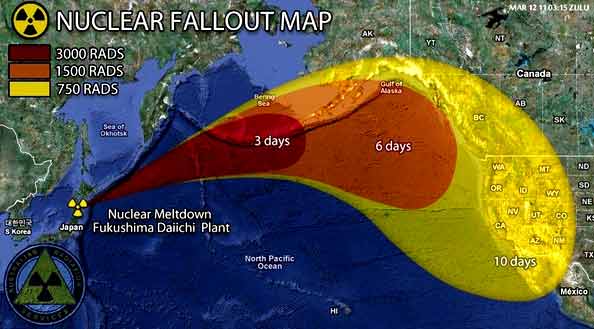Remember March 11. 2011. Fukushima: A Nuclear War without a War. Worldwide Nuclear Radiation
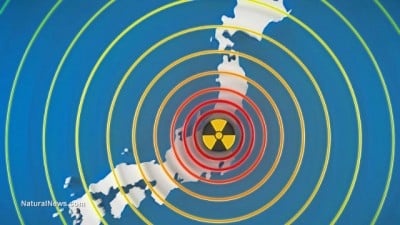
Global Research articles can be read in 51 languages by activating the Translate Website button below the author’s name (only available in desktop version).
To receive Global Research’s Daily Newsletter (selected articles), click here.
Click the share button above to email/forward this article to your friends and colleagues. Follow us on Instagram and Twitter and subscribe to our Telegram Channel. Feel free to repost and share widely Global Research articles.
Global Research Fundraising: Stop the Pentagon’s Ides of March
Introductory Note. Thirteen Years Ago. March 11, 2011
While commemorating the 13th anniversary of the Fukushima traged, the evidence amply confirms that this disaster has by no means been resolved.
The Fukushima disaster in March 2011 resulted in 16,000 deaths, causing some 165,000 people to flee their homes in the Fukushima area.
Both the Japanese and Western media tend to downplay the impacts of nuclear radiation which has spread to vast areas in Northern Japan, not to mention the contamination of water and the food chain.
The Fukushima disaster in Japan has brought to the forefront the dangers of Worldwide nuclear radiation.
The continued dumping of highly radioactive water into the Pacific Ocean constitutes a potential trigger to a process of global radioactive contamination.
“Unimaginable” levels of radiation still prevail. In the words of Dr. Helen Caldicott, “one millionth of a gram of plutonium, if inhaled can cause cancer”.
The massive storage of radioactive water has been ongoing since the 2011 tsunami disaster triggered a meltdown of the plant, but the International Atomic Energy Agency (IAEA) said [July 2023] the plan orchestrated by the Japanese government and TEPCO, the plant operator, meets safety standards.
TEPCO is planning a release of “1.3 million tons of treated wastewater” over a period of 30 years.
85 Times More Cesium than Chernobyl
Amply documented the Tokyo Electric Power Company (TEPCO) has been involved in a coverup. And so has the Japanese government. The Abe government had casually pointed to “harmful rumors”.
“After thirteen years, the declaration of a State of Emergency for Fukushima Daiichi Nuclear Power Plant still cannot be lifted because of many unknowns, as well as ubiquitous deadly radiation levels.
The destroyed reactors are tinderboxes of highly radioactive spent fuel rods that contain more cesium-137 than eighty-five (85) Chernobyls.
Cesium-137 in or near a human body erupts into a series of maladies, one after another in short order, depending upon level of exposure: (1) nausea (2) vomiting (3) diarrhea (4) bleeding (5) coma leading to death.”
The spent fuel rods at the Fukushima nuclear reactor site are stored in pools of water on the top floor of compromised reactor buildings 100 feet above ground level, except for Unit 3 which completed removal of its spent fuel rods in 2019, an extremely slow, laborious process that’s highly dangerous. (Robert Hunziker)
The present government’s stance remains notoriously ambiguous. Already in 2021, TEPCO acknowledged that the decommissioning of the Fukushima facility could last until 2051.
The Worldwide public health impacts which includes the contamination of the Pacific Ocean extending to the Western Hemisphere including the California coastline are incalculable.
The crisis in Japan has also brought into the open the unspoken relationship between nuclear energy and nuclear war.
Nuclear energy is not a civilian economic activity.
It is an appendage of the nuclear weapons industry which is controlled by the so-called defense contractors. The powerful corporate interests behind nuclear energy and nuclear weapons overlap.
Michel Chossudovsky, Global Research March 11, 2024
***
Originally published in January 2012, this study by Michel Chossudovsky confirms what is now unfolding: a Worldwide process of nuclear radiation.
The text was published as a chapter in Michel Chossudovsky’s 2015 bestseller:
The Globalization of War, America’s Long War against Humanity, Global Research, Montreal 2015
Fukushima: A Nuclear War without a War
By
Michel Chossudovsky
January 2012
Introduction
The World is at a critical crossroads. The Fukushima disaster in Japan has brought to the forefront the dangers of Worldwide nuclear radiation.
The crisis in Japan has been described as “a nuclear war without a war”. In the words of renowned novelist Haruki Murakami:
“This time no one dropped a bomb on us … We set the stage, we committed the crime with our own hands, we are destroying our own lands, and we are destroying our own lives.”
Nuclear radiation –which threatens life on planet earth– is not front page news in comparison to the most insignificant issues of public concern, including the local level crime scene or the tabloid gossip reports on Hollywood celebrities.
While the long-term repercussions of the Fukushima Daiichi nuclear disaster are yet to be fully assessed, they are far more serious than those pertaining to the 1986 Chernobyl disaster in the Ukraine, which resulted in almost one million deaths (New Book Concludes – Chernobyl death toll: 985,000, mostly from cancer Global Research, September 10, 2010, See also Matthew Penney and Mark Selden The Severity of the Fukushima Daiichi Nuclear Disaster: Comparing Chernobyl and Fukushima, Global Research, May 25, 2011)
Moreover, while all eyes were riveted on the Fukushima Daiichi plant, news coverage both in Japan and internationally failed to fully acknowledge the impacts of a second catastrophe at TEPCO’s (Tokyo Electric Power Co Inc) Fukushima Daini nuclear power plant.
The shaky political consensus both in Japan, the U.S. and Western Europe is that the crisis at Fukushima has been contained.
The realties, however, are otherwise. Fukushima 3 was leaking unconfirmed amounts of plutonium. According to Dr. Helen Caldicott,
“one millionth of a gram of plutonium, if inhaled can cause cancer”.
An opinion poll in May 2011 confirmed that more than 80 per cent of the Japanese population do not believe the government’s information regarding the nuclear crisis. (quoted in Sherwood Ross, Fukushima: Japan’s Second Nuclear Disaster, Global Research, November 10, 2011)
The Impacts in Japan
The Japanese government has been obliged to acknowledge that “the severity rating of its nuclear crisis … matches that of the 1986 Chernobyl disaster”. In a bitter irony, however, this tacit admission by the Japanese authorities has proven to be part of the cover-up of a significantly larger catastrophe, resulting in a process of global nuclear radiation and contamination:
“While Chernobyl was an enormous unprecedented disaster, it only occurred at one reactor and rapidly melted down. Once cooled, it was able to be covered with a concrete sarcophagus that was constructed with 100,000 workers. There are a staggering 4400 tons of nuclear fuel rods at Fukushima, which greatly dwarfs the total size of radiation sources at Chernobyl.” ( Extremely High Radiation Levels in Japan: University Researchers Challenge Official Data, Global Research, April 11, 2011)
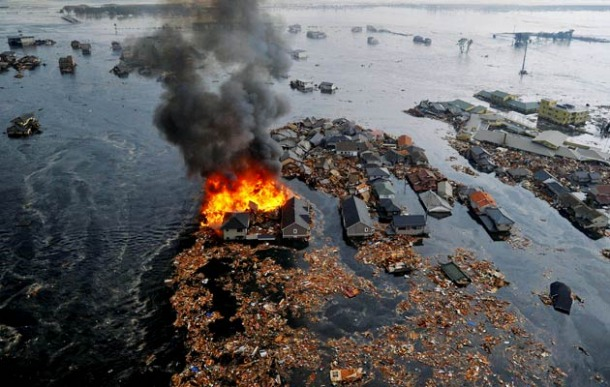
Fukushima in the wake of the Tsunami, March 2011
Worldwide Contamination
The dumping of highly radioactive water into the Pacific Ocean constitutes a potential trigger to a process of global radioactive contamination.
Radioactive elements have not only been detected in the food chain in Japan, radioactive rain water has been recorded in California:
“Hazardous radioactive elements being released in the sea and air around Fukushima accumulate at each step of various food chains (for example, into algae, crustaceans, small fish, bigger fish, then humans; or soil, grass, cow’s meat and milk, then humans). Entering the body, these elements – called internal emitters – migrate to specific organs such as the thyroid, liver, bone, and brain, continuously irradiating small volumes of cells with high doses of alpha, beta and/or gamma radiation, and over many years often induce cancer”. (Helen Caldicott, Fukushima: Nuclear Apologists Play Shoot the Messenger on Radiation, The Age, April 26, 2011)
While the spread of radiation to the West Coast of North America was casually acknowledged, the early press reports (AP and Reuters) “quoting diplomatic sources” stated that only “tiny amounts of radioactive particles have arrived in California but do not pose a threat to human health.”
“According to the news agencies, the unnamed sources have access to data from a network of measuring stations run by the United Nations’ Comprehensive Test Ban Treaty Organization. …
… Greg Jaczko, chair of the U.S. Nuclear Regulatory Commission, told White House reporters on Thursday (March 17) that his experts “don’t see any concern from radiation levels that could be harmful here in the United States or any of the U.S. territories”.
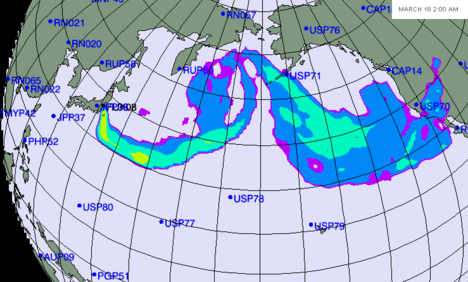
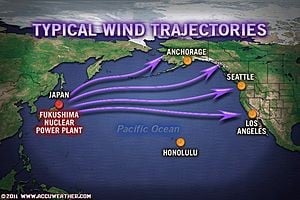
The spread of radiation. March 2011
Public Health Disaster. Economic Impacts
What prevails is a well organized camouflage. The public health disaster in Japan, the contamination of water, agricultural land and the food chain, not to mention the broader economic and social implications, have neither been fully acknowledged nor addressed in a comprehensive and meaningful fashion by the Japanese authorities.
Japan as a nation state has been destroyed. Its landmass and territorial waters are contaminated. Part of the country is uninhabitable. High levels of radiation have been recorded in the Tokyo metropolitan area, which has a population of 39 million (2010) (more than the population of Canada, circa 34 million (2010)) There are indications that the food chain is contaminated throughout Japan:
Radioactive cesium exceeding the legal limit was detected in tea made in a factory in Shizuoka City, more than 300 kilometers away from the Fukushima Daiichi nuclear power plant. Shizuoka Prefecture is one of the most famous tea producing areas in Japan.
A tea distributor in Tokyo reported to the prefecture that it detected high levels of radioactivity in the tea shipped from the city. The prefecture ordered the factory to refrain from shipping out the product. After the accident at the Fukushima nuclear power plant, radioactive contamination of tea leaves and processed tea has been found over a wide area around Tokyo. (See 5 More Companies Detect Radiation In Their Tea Above Legal Limits Over 300 KM From Fukushima, June 15, 2011)
Japan’s industrial and manufacturing base is prostrate. Japan is no longer a leading industrial power. The country’s exports have plummeted. The Tokyo government has announced its first trade deficit since 1980.
While the business media has narrowly centered on the impacts of power outages and energy shortages on the pace of productive activity, the broader issue pertaining to the outright radioactive contamination of the country’s infrastructure and industrial base is a “scientific taboo” (i.e the radiation of industrial plants, machinery and equipment, buildings, roads, etc).
A report released in January 2012 points to the nuclear contamination of building materials used in the construction industry, in cluding roads and residential buildings throughout Japan.(See FUKUSHIMA: Radioactive Houses and Roads in Japan. Radioactive Building Materials Sold to over 200 Construction Companies, January 2012)
A “coverup report” by the Ministry of Economy, Trade and Industry (May 2011), entitled “Economic Impact of the Great East Japan Earthquake and Current Status of Recovery“ presents “Economic Recovery” as a fait accompli.
It also brushes aside the issue of radiation.
The impacts of nuclear radiation on the work force and the country’s industrial base are not mentioned. The report states that the distance between Tokyo -Fukushima Dai-ichi is of the order of 230 km (about 144 miles) and that the levels of radiation in Tokyo are lower than in Hong Kong and New York City. (Ministry of Economy, Trade and Industry, Impact of the Great East Japan Earthquake and Current Status of Recovery, p.15).
This statement is made without corroborating evidence and in overt contradiction with independent radiation readings in Tokyo (see map below). In recent developments, Sohgo Security Services Co. is launching a lucrative “radiation measurement service targeting households in Tokyo and four surrounding prefectures”.
“A map of citizens’ measured radiation levels shows radioactivity is distributed in a complex pattern reflecting the mountainous terrain and the shifting winds across a broad area of Japan north of Tokyo which is in the center of the of bottom of the map.”
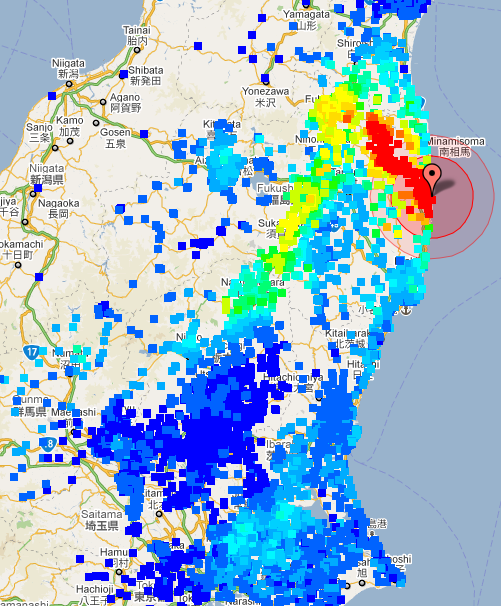
SOURCE: Science Magazine
“Radiation limits begin to be exceeded at just above 0.1 microsieverts/ hour blue. Red is about fifty times the civilian radiation limit at 5.0 microsieverts/hour. Because children are much more sensitive than adults, these results are a great concern for parents of young children in potentially affected areas.”
The fundamental question is whether the vast array of industrial goods and components “Made in Japan” — including hi tech components, machinery, electronics, motor vehicles, etc — and exported Worldwide are contaminated? Were this to be the case, the entire East and Southeast Asian industrial base –which depends heavily on Japanese components and industrial technology– would be affected. The potential impacts on international trade would be farreaching. In this regard, in January, Russian officials confiscated irradiated Japanese automobiles and autoparts in the port of Vladivostok for sale in the Russian Federation. Needless to say, incidents of this nature in a global competitive environment, could lead to the demise of the Japanese automobile industry which is already in crisis.
While most of the automotive industry is in central Japan, Nissan’s engine factory in Iwaki city is 42 km from the Fukushima Daiichi plant. Is the Nissan work force affected? Is the engine plant contaminated? The plant is within about 10 to 20 km of the government’s “evacuation zone” from which some 200,000 people were evacuated (see map below).
Nuclear Energy and Nuclear War
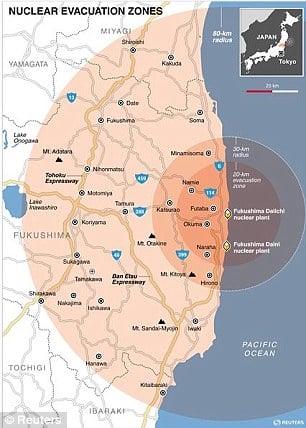
The crisis in Japan has also brought into the open the unspoken relationship between nuclear energy and nuclear war.
Nuclear energy is not a civilian economic activity. It is an appendage of the nuclear weapons industry which is controlled by the so-called defense contractors. The powerful corporate interests behind nuclear energy and nuclear weapons overlap.
In Japan at the height of the disaster, “the nuclear industry and government agencies [were] scrambling to prevent the discovery of atomic-bomb research facilities hidden inside Japan’s civilian nuclear power plants”.1 (See Yoichi Shimatsu, Secret Weapons Program Inside Fukushima Nuclear Plant? Global Research, April 12, 2011)
It should be noted that the complacency of both the media and the governments to the hazards of nuclear radiation pertains to the nuclear energy industry as well as to to the use of nuclear weapons.
In both cases, the devastating health impacts of nuclear radiation are casually denied. Tactical nuclear weapons with an explosive capacity of up to six times a Hiroshima bomb are labelled by the Pentagon as “safe for the surrounding civilian population”.
No concern has been expressed at the political level as to the likely consequences of a US-NATO-Israel attack on Iran, using “safe for civilians” tactical nuclear weapons against a non-nuclear state.
Such an action would result in “the unthinkable”: a nuclear holocaust over a large part of the Middle East and Central Asia. A nuclear nightmare, however, would occur even if nuclear weapons were not used.
The bombing of Iran’s nuclear facilities using conventional weapons would contribute to unleashing another Fukushima type disaster with extensive radioactive fallout.
For further details See Michel Chossudovsky, Towards a World War III Scenario, The Dangers of Nuclear War, Global Research, Montreal, 2011)
See also The Online Interactive I-Book Reader on Fukushima: A Nuclear War without a War


